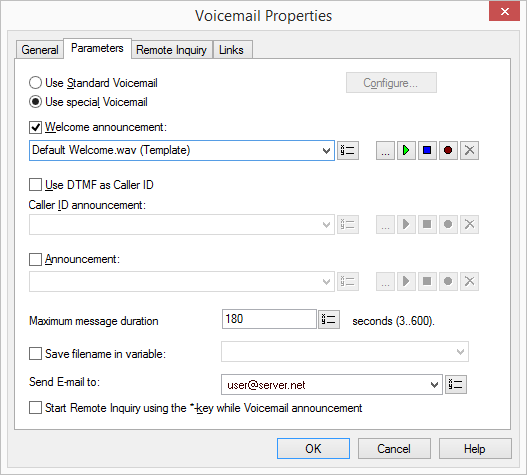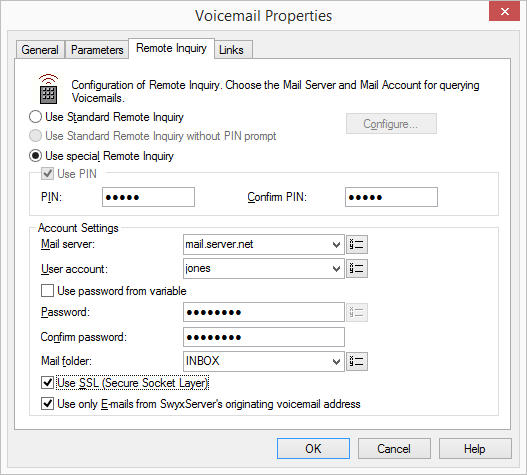If the caller’s number (Caller ID) is automatically transmitted, this will be saved together with the caller’s recorded Voicemail (message). You can then return the call using this number.
If no number is transmitted, then you can ask for the number in the following manner: The caller ID announcement will be played. “Please dial the number at which you can be reached. Conclude the entry of the telephone number with the hash button”. All DTMF input entered by the caller up to the hash button (#) will be saved as the caller ID.
Under “Properties”, all three tabs “General”, “Parameters”, "Remote Inquiry" and “Connections” tabs are available for this block.
1 Define whether you would like to use your normal Standard voicemail or whether you would like to use a special voicemail for this action (e.g. with a different announcement).
If you would like to use the Standard voicemail, activate this option. It is still possible to change these values here. To do so, click on "Configure…".
2 To define the text of the welcome announcement, activate “Welcome announcement”.
You have several options:

From the dropdown list select a file.

Browse your hard drive by clicking on

.
When searching, you can also choose a file in MP3 format. Upon selection, the MP3 file will automatically be converted into the WAV format and saved in the database on the SwyxServer. The converted files are therefore available for use later. During the conversion process, the Info dialog "Please wait, the file is being converted into WAV format" will open.

Click on

, to listen to the selected file. Click on

to stop playing the file.

To record a new announcement, click on

: You will now be prompted to enter a file name. The “Start Recording” window will appear. Click on “Start” to begin recording the announcement. Stop recording by clicking on

.

To delete the selected file, click on

.
| The WAV files, which the administrator has made available to all users, have the extension “(Template)” in the file name. These templates cannot be deleted. |
3 Activate “Use DTMF as Caller ID” in order to ask for the caller’s number if the number was not transmitted.
You can define the announcement as you did for the “Welcome Announcement”.
4 Activate “Announcement” in order to set other announcements (this only makes sense if you have already asked for the caller ID in the previous step
(3)).
You can define the announcement as you did for the “Welcome Announcement”.
5 Enter how long the caller’s message should be recorded (Timeout) in the field “Maximum message length … seconds”.
6 If you would like to save the name of the recorded file in a variable, activate this option and define the variable.
7 Indicate who the e-mail should be sent to in the field “Send E-mail to”.
8 Activate "Start Remote Inquiry using the *-key during Voicemail announcement" in order to listen to your voice mails or to remotely change your Call Forwarding Unconditional from another line.
9 Move to tab "Standard Remote Inquiry".
10 Define whether you would like to use your normal Standard Remote Inquiry (with or without PIN) or whether you would like to use a special Remote Inquiry for this action (e.g. with a different PIN):

If you would like to use the Standard Remote Inquiry, activate this option. It is still possible to change the Standard Remote Inquiry here. To do so, click on "Configure…".
The "Standard Remote Inquiry" tab will open.

If you would like to configure a special Remote Inquiry, which is only valid for this action, activate the option "Use special Remote Inquiry".
11 Define the PIN (Personal Identification Number) to be used for identification and confirm this here.
Select a five-digit, non-trivial sequence of numbers and confirm it.
| If you configure the Standard Remote Inquiry within a Call Forwarding or system rule, you will always be asked for your user PIN. There is no checkbox for this. If you are calling from your own extension number, for which this Call Forwarding was configured, you will not be asked for your PIN. |
12 In the field "Mail server" enter the name of the mail server to which your voice mails shall be sent.
13 In the field "User account" enter your user account for this mail server.
Please ask your administrator for the correct IMAP4 code of your user account . If it is a Microsoft Exchange Server, the correct code consists of the following: <Domain Name>/<Windows username>/<Exchange Alias>, e.g. domain/jt/jones.tom.
The integration of an IBM Domino/Notes is also possible. You will find further information on this topic in the support database in the following knowledgebase article: kb2757).
14 Enter your password on this mail server and confirm it.
If you would like to use a password of a variable, activate the checkbox "Use Password from Variable" and select the corresponding variable or add a new variable.
15 Enter the name of the e-mail folder containing the new voice mails. Use "INBOX" as a synonym for "mail received"
| Enter a subdirectory here and please make sure that the correct name, e.g. “INBOX/Voicemails” is completely entered. (In this case use a ’/’ and not a ’\’.) |
16 You can also define if SwyxServer shall use the security protocol SSL (Secure Socket Layer) during checking the voice mails at your mail server. Your mail server must support this protocol.
17 If only those e-mails, which were directly sent from SwyxServer, should be taken into consideration, activate the checkbox "Use only e-mails originating from SwyxServer (Voicemails)". This ensures that you will only receive your Voicemails during a Remote Inquiry.
18 Click on "OK" to close the window.
The “Voicemail” block can be seen on the grid interface and it available for further processing.
| If a message without reasonable contents has been recorded (shorter than 3seconds), it will be deleted and not sent. |


 .
. , to listen to the selected file. Click on
, to listen to the selected file. Click on  to stop playing the file.
to stop playing the file. : You will now be prompted to enter a file name. The “Start Recording” window will appear. Click on “Start” to begin recording the announcement. Stop recording by clicking on
: You will now be prompted to enter a file name. The “Start Recording” window will appear. Click on “Start” to begin recording the announcement. Stop recording by clicking on  .
.